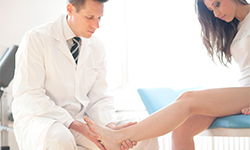Foot

Our foot consists of 26 bones, 24 muscles and approximately two dozen joints.
Disorders of the complex interaction of all mobile segments can impair the gait and cause pain during walk or stand. As I have laid my clinical and scientific focus on foot surgery it is usually easy for me to treat even chronic and complex foot disorders successfully.
Common causes for foot pain are:
- Deformities: The Hallux Valgus, the Hammer Toe or the Clubfoot slightly deteriorate over years and often lead to persistent pain.
- Arthritis: Increased wear of the joints (=Arthritis) can be caused by chronic overload or previous injuries. Ankle Arthritis or arthritis of the first metatarsal joint (=Hallux Rigidus) are common diseases which cause pain and swellings.
- Inflammation of the tendons: In most cases Plantar Heel Pain is caused by an inflammation of the plantar fascia (Plantar Fasciitis). In some cases a painful achilles tendon is caused by an osseous bump on the heel bone (Haglund Exostosis).
- Compression syndromes of the peripheral nerves: In cases of chronic compression of the peripheral nerves (e.g. Morton’s Neuroma, Tarsal Tunnel Syndrome) pain is often accompanied by sensory deficits.
- Comorbidity: Patients which have suffered from diabetes for years often show sensory deficits (neuropathy) and impaired blood perfusion (angiopathy). As a consequence chronic foot wounds with a decreased healing capacity can occur. (=Diabetic Foot Sydrome).
- Injuries: A ruptured Achilles Tendon und Ankle Strain are one of the most common sport injuries.
Treatment
For me a detailed interview and an exact physical examination are the most important preconditions to find the correct diagnosis. Apart from that, full weight-bearing radiographs of the foot are essential. Only in a few cases further examinations like sonography, magnet resonance imaging (MRI), neurological examinations or gait analysis are necessary.
Most foot disorders can be treated without surgery. Physiotherapy, shockwave therapy, the application of anti-inflammatory drugs or cortcoid injections are often effective. The support of an orthopedic shoemaker who enables a high- quality patient-matched supply with insoles and orthopaedic shoes is of outstanding importance.
In some cases long lasting pain relief can only be achieved by surgery. I use open, minimal-invasive and arthroscopic techniques according to the underlying disease and the patient’s preference. I perform each procedure according to the latest scientific standards to fulfill the high expectations of my patients.

